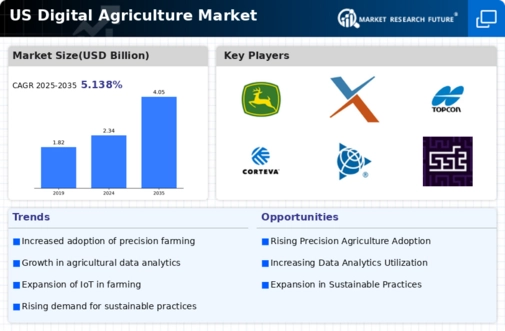The US Digital Agriculture Market has experienced significant growth as advancements in technology have influenced traditional farming practices. This segment encompasses a wide array of technologies such as precision agriculture, data analytics, and Internet of Things (IoT) applications, which collectively enhance crop yields and reduce costs for farmers. A competitive landscape has emerged, characterized by established players and new entrants striving to develop innovative solutions that cater to modern agricultural needs.
Key factors driving competition include investment in research and development, strategic partnerships, and the implementation of sustainable practices aimed at meeting both regulatory requirements and consumer demand for environmentally friendly farming methods. Furthermore, the integration of advanced analytical tools and automation technologies presents both opportunities and challenges, as companies look to differentiate their offerings in a market eager for efficiency and productivity. John Deere stands as a prominent figure in the US Digital Agriculture Market, capitalizing on its extensive history and reputation for agricultural machinery.
The company's strengths lie in its robust portfolio of precision agriculture solutions, which integrate advanced data analytics with farm equipment to optimize farming operations. Through its commitment to innovation, John Deere has developed a comprehensive suite of products that enhance tractor performance, enable real-time data access, and facilitate interoperability among different farm machinery. Furthermore, its strong distribution network and customer service capabilities enable the company to maintain a solid market presence.
John Deere’s continuous investment in technology, particularly in artificial intelligence and machine learning, reinforces its competitive edge, allowing it to adapt to shifting consumer needs and market trends effectively.AgJunction represents a key player in the US Digital Agriculture Market, focusing on providing technology solutions that aim to improve farm productivity. The company specializes in precision agriculture technologies, including guidance systems and software solutions designed to enhance the efficiency of farming operations. AgJunction’s strengths lie in its commitment to delivering user-friendly products that promote data-driven decision-making for farmers.
The company has strategically established partnerships and collaborations to extend its reach and improve product offerings, enhancing its presence within the market. Its innovative solutions address various agricultural needs, such as field mapping and automated steering systems. Furthermore, AgJunction has pursued mergers and acquisitions to augment its technology portfolio, which has enabled it to remain competitive. By focusing on delivering tailored solutions to individual farmers and ensuring customer support, AgJunction has solidified its role as a critical player in the evolving landscape of digital agriculture in the US.





















